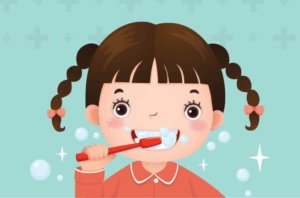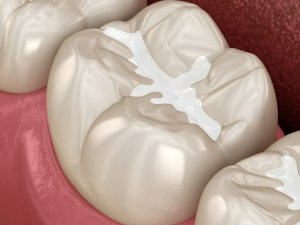When you think about the most common infectious disease in children, tooth decay probably isn’t what comes to mind first. However, almost half of children in the United States have it. Tooth decay in kids is responsible for the loss of over 51 million hours of school. Cavities are one of the most common dental problems in toddlers and children. Also referred to as tooth decay, a cavity is a permanently damaged area in a tooth. They can develop in your child’s primary or baby teeth, and if so, you might shrug it off — your child will eventually lose these teeth, right? So what does it matter? But you shouldn’t ignore a cavity. Here’s what you need to know about cavities in kids, including common causes, treatment options, and …
Here we discuss a variety of topics related to pediatric dentistry at our Ladys Island office.
A Parent’s Guide to Teaching Kids How to Brush Their Teeth
Your child doesn't have to be among the 42 percent of kids aged two through 11 years old with tooth decay, according to the American Academy of Pediatric Dentistry. In fact, by learning where to begin when teaching kids to brush their teeth and building good dental hygiene habits, you can help your kids be among the 80 percent of kids who don't have untreated decayed teeth. Why It's Important for Kids to Get Started Early Caring for Their Teeth Starting good oral care when your child is at an early age is essential for the long-term health of their teeth. As a parent, you can teach your child how to brush and floss just by taking some key steps. Why Brushing Baby Teeth Is Important A healthy smile early on leads to a …
Celebrate Children’s Dental Health Month with these Oral Health Care Tips
During the month of February, the American Dental Association celebrates National Children’s Dental Health Month. This month-long national health observance reinforces the importance of oral health in children as well as helping parents with tips to keep their child’s smile on track! At Lowcountry Family Dentistry, our dentists and staff are taking this opportunity to share oral health tips and raise awareness of the importance of pediatric dental care at an early age. First Tooth, First Birthday, First Dental Visit. New parents often ask, “When should my child first see a dentist?” It’s never too early to start focusing on your child’s oral health! The American Association of Pediatric Dentists recommends that parents establish a dental …
Teething Symptoms & How to Help
New parents sometimes anticipate their baby's first tooth with a mixture of excitement and worry. While reaching a new developmental milestone is always a cause for celebration, this particular one can come with considerable discomfort. However, teething is different for each baby, and need not be painful at all; plus, there are steps you can take to make the process easier for your baby — and yourself. Teething refers to the process by which primary (baby) teeth emerge through the gums and become visible in the mouth. This usually begins between six and nine months of age, though it may start as early as three months or as late as one year. Usually, the lower front teeth erupt first, followed by the ones directly above. Most children …
Why Are Dental Sealants So Important?
Brushing and flossing are the best ways to help prevent cavities, but it’s not always easy to clean every nook and cranny of your teeth – especially those back teeth you use to chew (called molars). Molars are rough, uneven and a favorite place for leftover food and cavity-causing bacteria to hide. Still, there’s another safety net to help keep those teeth clean. It’s called a dental sealant, and it is a thin, protective coating (made from plastic or other dental materials) that adheres to the chewing surface of your back teeth. They’re no substitute for brushing and flossing, but they can keep cavities from forming and may even stop early stages of decay from becoming a full-blown cavity. In fact, sealants have been shown to reduce …
What is Orthodontics?
Braces and orthodontic treatment are used to correct “bad bites,” or malocclusion (teeth that are crowded or crooked). In some cases your teeth may be straight, but your upper and lower jaws may not meet properly. These jaw or tooth alignment problems may be inherited or could result from injury, early or late tooth loss, or thumbsucking. If you have an abnormal bite your dentist may recommend braces or another orthodontic treatment to straighten out your smile. Correcting the problem can create a nice-looking smile, but more importantly, orthodontic treatment results in a healthier mouth. Not correcting an abnormal bite could result in further oral health problems, including: tooth decay gum disease tooth loss affected …
When Do Baby Teeth Come In?
If you think your baby’s toothless smile is cute, just wait until their first few teeth make an appearance. With it being National Children's Dental Health Month, we'll again keep with our children theme. A baby’s 20 primary teeth are already present in the jaws at birth and typically begin to appear when a baby is between 6 months and 1 year. Most children have a full set of 20 primary teeth by the time they are 3. Check out this baby teeth eruption chart to see the order in which teeth break through and at what ages you can expect specific teeth to appear. Every child is different, but usually the first teeth to come in are located in the top and bottom front of their mouth. When teeth first come in, some babies may have sore …
Baby Bottle Tooth Decay FAQ
Even though they are temporary, your child's baby teeth are important, and are still susceptible to cavities. Tooth decay in infants and toddlers is often referred to as Baby Bottle Tooth Decay, or Early Childhood Caries. Children need strong, healthy teeth to chew their food, speak and have a good-looking smile. Their first teeth also help make sure their adult teeth come in correctly. It’s important to start infants off with good oral care to help protect their teeth for decades to come. What Causes Baby Bottle Tooth Decay? Baby Bottle Tooth Decay most often occurs in the upper front teeth, but other teeth may also be affected. There are many factors which can cause tooth decay. One common cause is the frequent, prolonged exposure of …
What is National Children’s Dental Health Month?
February is National Children’s Dental Month. The American Dental Association (ADA) sponsors this movement to raise awareness about the importance of dental health for children. What Is National Children’s Dental Health Month (NCDHM)? NCDHM is a month-long national health observance that brings together thousands of dedicated educators, healthcare providers, and dental professionals (Lowcountry Family Dentistry included!) to promote the benefits of good oral health to children, their caregivers, teachers, and many others. This year, the campaign slogan is “Choose Tap Water for a Sparkling Smile.” The ADA supplies information on making better beverage choices in the form of posters, planning guides, press releases, and activity …
Pediatric Anesthesia & Sedation Questions for Your Dentist
The ADA offers the following questions that parents and guardians should ask concerning in-office sedation or general anesthesia for their children provided either by the dentist or by a separate sedation/anesthetic practitioner in that dental office. The ADA suggests talking with your dentist about any concerns you might have about the treatment plan prior, during and after the procedure. Prior to the procedure: Who will provide evaluate my child before the procedure, including their past medical history such as allergies, current prescription and over-the-counter medications and previous illnesses and hospitalizations? How long should my child go without food or drink prior to the procedure (with the exception of necessary …










